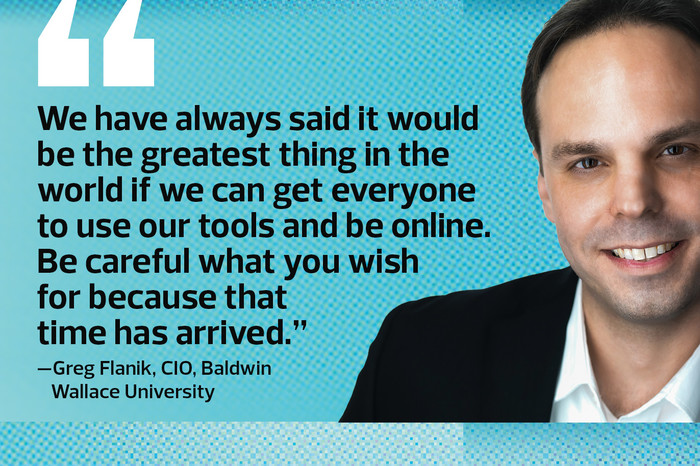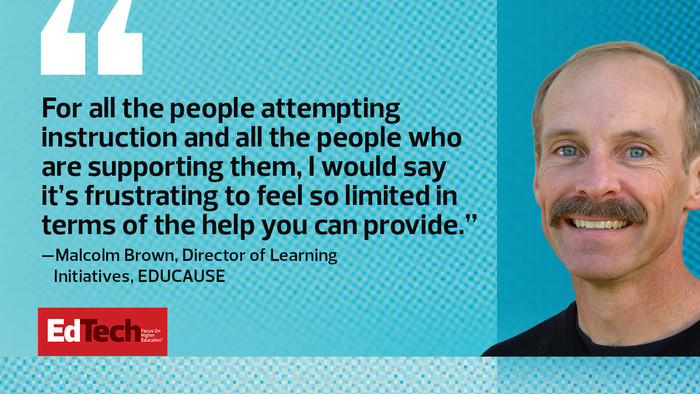It’s no secret that, even while acknowledging the benefits, many in higher education have long viewed online education and remote learning with some degree of skepticism. Fast-forward to this year’s novel coronavirus pandemic, however, and even skeptics find themselves embracing remote learning — like it or not, ready or not.
With universities everywhere forced to indefinitely shut their classroom doors until the health crisis ends (or at least stabilizes), remote learning has become the only option for ensuring students can finish the classes, credits and degrees in which they’ve invested. While this new reality presents a major challenge for traditionalist educators, it also offers higher ed IT pros a significant (and multifaceted) opportunity: to demonstrate the value and leadership they can provide by guiding educators deeper into the era of online and remote learning.
With this in mind, EdTech spoke to three experts: Malcolm Brown, director of learning initiatives at EDUCAUSE; Greg Flanik, CIO of Baldwin Wallace University in Ohio, and Monique Sendze, CIO for the Colorado School of Mines.
EDTECH: What has life been like in the days since higher education made this massive shift to remote learning?
MALCOLM BROWN: I would say life has been a mix of hellishness, exhaustion and a sense of accomplishment. It’s hard to see anyone struggle, especially students and faculty who are facing new situations and things they’re unfamiliar with. For all the people attempting instruction, as well as those who are supporting them, I would say it’s frustrating to feel so limited in terms of the help you can provide. But I also imagine there are a lot of success stories going on out there and a lot of hard work is paying off.
MONIQUE SENDZE: Our infrastructure and security teams have been busy provisioning servers to build new infrastructure. We’ve been in an emergency purchasing mode, furiously buying new licenses and upgrading existing licenses to support the number of users that will now be simultaneously using the tools. We stood up a system to securely provide students remote access to computer labs with the specialized software they need. We even set up a completely new support infrastructure for responding to remote learning needs. And, rather than doing this in weeks or months, we’ve had to stand up all of this in a matter of days. My team has really pulled off some heroics. They’ve demonstrated that IT can respond to a crisis and do so quite quickly.
GREG FLANIK: I would almost say it’s like when you see that row of ducks going across the lake: Everything looks very calm and smooth on top, but there’s a lot of scurrying under the water. If you look at our institution, there’s a sense of calm that we have a handle on it, but at the same time I’m not going to dismiss that people are running crazy to help people get online.
When the announcement was made, I told our team, “Never let the opportunity from a crisis go to waste. We have always said it would be the greatest thing in the world if we can get everyone to use our tools and be online. Be careful what you wish for because that time has arrived.”
EDTECH: What role should IT play in helping universities respond to the remote learning needs they’re facing, both in the short and the longer term?
BROWN: I think the biggest thing is just sharing. How do I do this? I've never done this before. Who's got a good answer for this problem, or that, and this other thing? The way that everyone has come together across institutions and shared what they know and helped each other out is probably the biggest single thing. Each institution has to shoulder this burden and get these courses moved online, and the sharing allows them to really move forward more quickly.
Then there are nontechnical things, something as simple as empathizing with each other and offering an acknowledgement that we're all under a lot of stress, and it's a very difficult situation. Sometimes we're having a videoconference or a class session on Zoom, and someone's dog will bark, or someone's cat will walk across the desk or something like that. Just demonstrating patience with these types of intrusions can help contribute to everyone moving forward despite the challenges.
SENDZE: There’s this culture and perception in higher education that it takes forever to get anything done. But IT departments have really galvanized and responded in ways that will have both short-term and long-term effects. We’ve shown that we can be agile and that we can come up with creative solutions to problems in days, not years. In the process, what I’ve seen emerge is leadership by IT in areas that I would not have expected. We’ve also seen very tight-knit collaboration that will remain after this is all said and done. I think this is the moment for higher education to flip how we envision the design and delivery of instruction, and IT will be at the table.
MORE ON EDTECH: 3 Remote Learning Technology Must-Haves for Higher Education
FLANIK: Know your bell curve and don’t make it complicated. You’re going to have 10 to 15 percent who know this stuff and for whom this is going to be the greatest thing in the world. You’re going to have middle-of-the-road people, which will make up the majority of your audience. Those are the ones you don’t want to confuse. Then you have 15 percent who say, “Over my dead body will I teach an online course. I became a faculty member to lecture in a classroom.”
My instructional designers have great ideas for what a perfect online course should be. But that wasn’t going to happen with 250 faculty members to prepare in a week and a half. This is when you put the student first and say, “I have to enable the faculty member to deliver the content so the student can get credit for the course.”
EDTECH: Do you think this moment has created a cultural shift in how faculty and students accept and value remote learning?
BROWN: Another way to frame this question is whether we think this will encourage institutions to do more fully online course delivery than before, and I don’t think we can predict that right now. Think about, for example, schools with extensive dormitory systems. They’re not going to want to see them sit empty in fall 2020 — their financial model includes the dorms. I’m sure the culture will shift somewhat toward online learning, but how extensively remains to be seen.
SENDZE: If higher education doesn’t come out of this experience looking at every aspect of how we function, then I don’t know what else would change us. I do think universities that lack a strong online presence will start looking at developing hybrid deliveries. And I think it’s going to really reshape how the higher education curriculum is designed.
My university president has clearly said that he wants to look at the lessons learned and see which things developed through this process could become a part of doing business. We don’t just dismantle it and toss it. We look at it and say, “Okay, we did this, it worked great. How do we embed it and make it part of the way we do business?”
MORE ON EDTECH: How University Faculty Embraced the Remote Learning Shift.
FLANIK: Absolutely. We're already seeing it. We started registering for our summer courses, which start in May, and we already made the announcement that we're going to teach those online. And since students knew it was going to be online, we've already seen a 30% increase in registrations. At [a recent meeting] everyone said, "Wow. I don't understand why we got 30% more students signed up for online courses." I said, "I do. We got them all online. That's how they want to take the classes during the summer. They don't want to sit in a classroom at a university campus when the weather is 84 degrees. They want to be able to jump on and do the courses when they want, how they want."
I think new business models are certainly going to emerge from this, and I think it's going to change the way we teach, and I think it's going to change the expectations that the students have.
81%
Percentage of college presidents surveyed who said their No. 1 concern with remote learning was keeping students engaged
Source: insidehighered.com, “Presidents Fear Financial, and Human, Toll of Coronavirus,” March 27, 2020
EDTECH: How have recent events shaped how you might think about and prepare for similar events in the future?
BROWN: It’s been a wake-up call. I’m sure institutions are thinking about what happens if this current crisis extends over time, for instance, like the Spanish flu of 1918 and 1919, which came in three separate waves — two in 1918 and one and 1919. I would be thinking about whether I'm going to plan now for an extension of remote teaching and about how can I better equip and support learners and faculty should the situation extend into the fall semester for 2020.
On the other hand, I’ve gotten indications that some folks are planning for a return to normal operations in fall 2020, which means back to face-to-face. Campus academic planners have to prepare for two scenarios in parallel. One is back to normal, and the other is what happens if this current situation should return in one way or another, maybe in a milder way, but still in a way that requires some measure of social distancing. It’s a really tough question, and at this point, no one can predict what’s going to happen in the fall.
SENDZE: As IT professionals, we responded in a rush. It was a crisis. We came in like a SWAT team and started working on solutions. But as I think about the next crisis and wonder how IT can prepare for the future, I can say that, yes, we may talk about these things in our business continuity and disaster recovery plans more than before.
FLANIK: I think there’s a clear roadmap that we need to look at. I see opportunities and touchpoints for us to engage our administration and our faculty leadership to take a look at this, because we are where we are, and we can’t just go back. So, we have to create a personal experience and build a new market for delivering instruction.
I’m excited about it. I’ve had conversations with other folks about it, and there’s a willingness to rally and build on it. The longer this lasts, the more likely that it becomes an accepted mode of learning.














